Soul Calibur II Import Preview
Namco brings its arcade hit home to the GameCube.
Namco has been refining its "Soul" fighting series steadily since the franchise first hit arcades in 1996. The first entry, Soul Edge, hit arcades in 1996 and garnered a loyal cult following because of its tight gameplay and smartly implemented weapon-based fighting system. A home conversion of the game, called Soul Blade, was released on the PlayStation in 1997. In addition to being a solid port of the arcade game, Soul Blade featured an impressive array of extras that added a solid amount of replay value to the game. The next installment in the series, Soul Calibur, was released in arcades in 1998. The game featured a larger cast and some excellent refinements to the already solid gameplay of its predecessor. This impressive sequel was developed on Namco's System 12 arcade board, the successor to its System 11 arcade hardware. While both boards were based on PlayStation architecture, the System 12 featured a few refinements that would make a home conversion to the PlayStation a challenge.
Rather than attempt the port, Namco opted to bring Soul Calibur to Sega's Dreamcast platform. The Dreamcast version of Soul Calibur was released at the system's US launch in September of 1999 and instantly became one of the platform's killer apps. Unlike the conversion of Soul Blade, the conversion of Soul Calibur received a stunning upgrade in its visuals, nicely highlighted by the game's support of the Dreamcast VGA box peripheral and a solid amount of extra content exclusive to the home game. Unfortunately for fans of the series, Namco wouldn't release a follow-up to Soul Calibur until 2002. Soul Calibur II, which was first shown off at February 2002's AOU arcade show in Japan, was developed on Namco's System 246 hardware, which is based on PlayStation 2 hardware. The game offered enhanced graphics, new playable characters, gameplay tweaks, and new gameplay modes. Following the game's official release in arcades later that year, word hit that Namco would be bringing the game to the GameCube, PlayStation 2, and Xbox platforms with some unique extras. We've had the chance to check out the recently released import version of Soul Calibur II for the GameCube and are pleased to report that Namco's excellent fighter has made an impressive leap home. The conversion of the arcade game's graphics and gameplay are nearly perfect, and Namco has thrown in a hearty helping of extras that should please fans and GameCube owners alike.
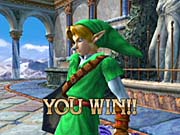
When you first start the game you'll be treated to an original CG intro that introduces you to the game's core cast of fighters. You'll find 15 selectable characters available at the start. Mitsurugi, Taki, Yunsung, Kilik, Xianghua, Maxi, Ivy, Nightmare, Astaroth, and Voldo should be familiar to fans of the series. Talim, Cassandra, and Raphael are newcomers to the series, introduced in the arcade version of Soul Calibur II. In addition to the veteran characters, you'll find two new faces in the mix exclusive to the home version of the game. Necrid is a green hulk who is based on the drawings of Todd MacFarlane, and the most notable addition to the roster of fighters, exclusive to the GameCube, is Nintendo's Link. The green-clad hero from the Legend of Zelda series has been modeled after his Ocarina of Time incarnation and fits in with the cast surprisingly well.
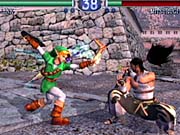
Soul Calibur II will initially offer two main modes to explore: original and weapon master. Original mode offers seven types of games: arcade, versus battle, time attack, survival, team battle, versus team battle, and practice. Arcade re-creates the experience of playing the arcade game and puts you in a series of battles that lead up to the final confrontation with the game's end boss. Versus battle lets you duke it out with a friend on any of the stages in the game. Time attack challenges you to plow through your foes as quickly as possible in one of three types of battles: standard, alternative, and extreme. Survival gauges your fighting skills against an unrelenting series of foes to see how many you defeat before your health is depleted. Team battle lets you pick a team of three fighters and engage in a series of fights against other teams. Versus team battle lets you pit your team of three against a friend's. Finally, practice lets you test your skills against a CPU opponent whose behavior you can configure to your liking.
The game's weapon master mode is a mission-based mode along the lines of the edgemaster and mission modes seen in previous home versions of games in the series. You'll go to different locations on a world map and clear various challenges. The challenges range from standard one-on-one fights with specific conditions for victory to battles in which you're affected by status-changing effects such as health-depleting "poison" that slowly eats away at your health bar. Some locations will include exploration segments that will have you engaging in a series of fights as you search for a treasure room. As you clear the various challenges, you'll earn experience and gold. Your experience will affect your title, while you'll use your gold in shops located in each area to buy a variety of items.
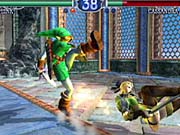
The weapon master mode is also the primary way to unlock the plethora of new content Namco has added to the home version. You'll find five playable characters to unlock: returning favorites Yoshimitsu, Cervantes, Sophitia, and Seung Mina and newcomer Charade. A new "extra" gameplay mode features variations of the game types seen in the original mode. An unlockable museum features an art gallery with three sets of artwork you can buy in the weapon master shops. A battle theater lets you watch any two characters of your choosing duke it out. An exhibition theater lets you watch the animation sequences of all the characters going through a series of fighting moves, which demonstrates Namco's excellent use of motion capture. The character-profiles option lets you check out a text bio on each of the fighters, get a look at their stage, and cycle through their various voice samples, which shows off the impressive facial animation in the game. A weapon gallery lets you look at the insane arsenal of weapons you can collect in the game--you'll be able to collect 12 weapons per character. Finally, a demo theater lets you check out the various character and mode ending movies in the game once you've unlocked or purchased them.
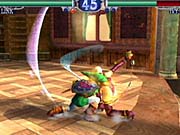
Unlocking the various extras isn't too tough thanks to the polished gameplay in Soul Calibur II. The game's combat system is a refinement of the system in Soul Calibur, though the core fighting mechanics remain as solid as ever. Characters have had moves added and power levels adjusted to better balance the roster. The characters from the arcade version all feel pretty well balanced and work well together. The new characters--Link, Necrid, and the unlockable fighters--throw the balance off slightly, though they fit pretty well into the mix as a whole. Necrid and Charade are cut from the same cloth as the edgemaster character last seen in Soul Calibur, and they make liberal use of the fighting styles used by other characters. Link's unique moves, especially his projectile attacks, give him a slight advantage over the other characters in the game, and his boomerang, arrows, and bombs may pose a problem initially, but the game's eight-way movement keeps things fair in the end.
You can control the game surprisingly well with the GameCube pad. You'll have the option of using the digital or analog pads to move your character around. The default control scheme assigns horizontal attack to the A button, vertical attack to the Y button, kick to the X button, and guard to the B button. You'll also have some redundant controls thrown in to help with more complicated button presses. The triggers will block, the Z button will register as holding down A, Y, and X, and the C stick will serve as a shortcut key of sorts with up, down, left, and right counting as various button combinations, much like in Capcom's Capcom vs. SNK 2 EO. If the default layout isn't to your liking, you'll find two other presets and the option to customize the controls to suit your tastes.
The graphics in Soul Calibur II on the GameCube are quite impressive. The look of the arcade game has been faithfully re-created and improved on in some places. The high-poly character models have detailed faces, highlighted by such features as lip-synching and head-tracking. Animation, one of the standout features in every entry in the series, is polished as always, with the various fighting styles being well represented by a solid mix of motion-captured and hand-drawn animation. Detail on clothing is impressive as well, with clean textures being used to show off the intricate patterns on the clothing, weapons, and armor. The graphical quality seen in the characters is, for the most part, present in the arenas as well. As in the previous games, the arenas will be confined to set areas with detailed elements in the backgrounds. Only a few of the backgrounds feature animation--newcomer Talim's stage features the most dramatic use of it with a bizarre clockwork contraption cranking along during brawls. While most of the other arenas don't use anything as dramatic as the gears in Talim's stage, you'll find some animated elements among them. Cherry blossoms, flowing lava, mist, and crackling fire are all on hand to lend some atmosphere to the brawls. During battles you'll also be treated to a nice helping of particle and lighting effects as a result of the various weapon attacks and collisions in the game. The effects are highlighted by the rich color palette that takes advantage of the GameCube hardware. In spite of the aforementioned graphical bounty, the game manages to stay at a fairly solid rate of 60 frames per second throughout. There are a few instances of slight slowdown but nothing horrible. The icing on the visual cake can be found in the game's video options, which offer 480p progressive scan and widescreen support.
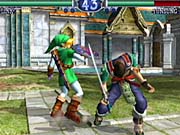
Audio in the game is stellar as well. All the characters feature strong voice acting--even Link, whose sound bites consist of grunts and yells. Crisp sound effects do a fine job of framing the onscreen action as weapons clash and fighters are slammed to the ground in the heat of battle. The game's soundtrack is solid, though slightly less catchy than the one heard in Soul Calibur, and the game's support of Dolby Pro Logic II is a welcome feature that should make bland tunes easy to overlook.
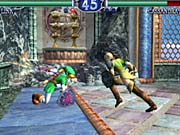
The import version of Soul Calibur II adheres to Namco's high standards for home conversions. Impressive graphics with progressive scan support and strong audio features provide an excellent audio and visual showcase for the GameCube. The solid conversion of the arcade game and the addition of extra gameplay modes, a plethora of unlockable content, and Link as a playable character give the game an addictive amount of replayability. While the whole package may sound pretty enticing, gamers will have to wait to play the game until this August when Soul Calibur II ships for the GameCube, PlayStation 2, and Xbox. Hopefully Namco will make use of the time before release to add some more content to the game, such as playable characters, and to iron out the few frame rate hitches. Even so, as it stands now, Soul Calibur II is a game that GameCube owners, especially fighting fans, will want to get. Given the sparse entries in the 3D fighting genre on the platform, Soul Calibur II should be just what the doctor ordered, and it looks and plays great. Look for more on Soul Calibur II in the coming months.
Got a news tip or want to contact us directly? Email news@gamespot.com
Join the conversation